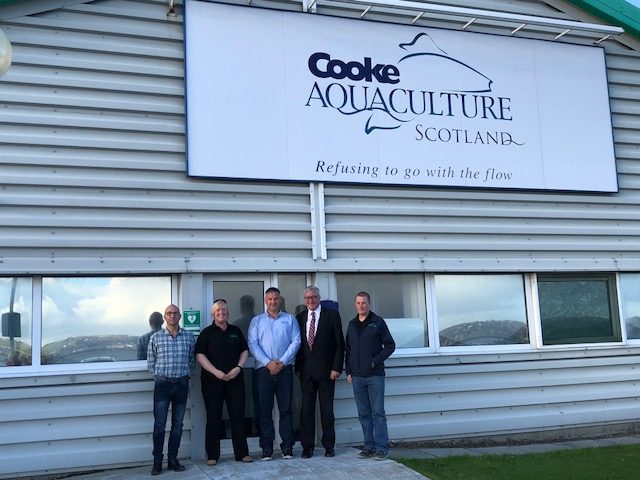Scottish Cabinet Secretary Ewing learns more about Cooke’s high-energy site.
On Thursday, September 27th, the Scottish Government’s Cabinet Secretary for Rural Economy, Fergus Ewing, visited Cooke Aquaculture’s Orkney headquarters in Kirkwall to hear about progress made at the company’s new high-energy salmon farming site at East Skelwick, North Sound, Westray.
High wind
The new site will consist of eight pens measuring 130 metres in circumference, the largest currently used in Scotland. Compared to existing farms, the East Skelwick site is in a more exposed location – 2.5km from the nearest landfall – and is equipped with technology that can withstand sustained exposure to high wind and wave loads.
The new equipment includes a wave measurement buoy, a weather station incorporating hydrographic sensors, and real-time environmental sensors. They have been procured with assistance from the European Maritime and Fisheries Fund (EMFF), negotiated by the Scottish Aquaculture Innovation Centre (SAIC) with Marine Scotland.
Mr Ewing said: “Cooke are championing innovative approaches to sustainably growing the Scottish aquaculture industry, and are a fantastic example of what can be achieved in Scotland when there is a combination of vision and wider support. It was great to see yet another example of how the aquaculture sector is adapting and being innovative when thinking about sustainable growth, and I wish them all the best moving forward.”
Extreme weather events
“To maximise the data gained from the new site, wind, wave and hydrographic conditions will be monitored in real-time, alongside routine farm operational observations,” said Colin Blair, Managing Director, Cooke Aquaculture Scotland. “This enables the resilience of cages and moorings, site accessibility and salmon performance to be correlated with the prevailing physical conditions, including any extreme weather events.”
“We’re delighted with the progress at Cooke’s high-energy site, and with having helped generate EMFF funding for its equipment. We will liaise with Cooke Aquaculture to help ensure that the important data from these instruments is interpreted fully, allowing a more accurate assessment of site performance. This will give the industry good, usable information for these types of sites going forward,” added Dr Robin Shields, Senior Aquaculture Innovation Manager at the Scottish Aquaculture Innovation Centre (SAIC).


